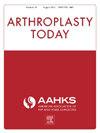非烟草尼古丁依赖与全髋关节置换术术后并发症之间的关系?一项大型倾向匹配队列研究
IF 2.1
Q3 ORTHOPEDICS
引用次数: 0
摘要
背景:非烟草尼古丁依赖(NTND)是传统烟草使用的一个日益增加的替代品。然而,NTND患者接受全髋关节置换术(THA)的数据有限。本研究的目的是调查有和没有NTND的患者在THA手术中的并发症和翻修率的差异。方法使用ICD-10和CPT代码查询TriNetX美国协作网络数据库,识别2014年至2024年间18岁及以上的原发性THA患者。根据NTND病史和基于年龄、性别、种族、民族、体重指数和合并症的倾向匹配来划分队列。比较并发症和翻修THA的发生率。结果18岁及以上患者共99496579例,其中192826例行原发性THA。排除后,15,561人(93.2%)为非尼古丁使用者,8452人(6.8%)为NTND。经1:1倾向评分匹配后,每个队列纳入8378例患者。NTND患者术后90天的并发症包括心肌梗死、卒中、肺炎、急性肾损伤、败血症、急诊科就诊和再住院显著高于其他患者(P <;. 05)。术后1年,除上述并发症外,术后深静脉血栓形成风险([OR] 1.251;P = 0.0369)和感染(OR 1.288;P = 0.045)显著增高。假体关节感染率(OR 1.485;P = .004),修正THA (OR 1.868;P = 0.002)和死亡(OR 1.575;P = 0.035)在术后90天、1年和5年NTND患者中显著升高。结论sntnd患者有较高的感染率、翻修率、死亡率和术后并发症,包括深静脉血栓形成、心肌梗死、卒中、肺炎、肾损伤、败血症、感染和复住率。提供者应建议NTND患者,并在手术治疗前考虑筛查方案。证据水平回顾性队列研究,证据水平为III。本文章由计算机程序翻译,如有差异,请以英文原文为准。
What is the Association Between Nontobacco Nicotine Dependence and Postoperative Complications in Total Hip Arthroplasty? A Large Propensity-Matched Cohort Study
Background
Nontobacco nicotine dependence (NTND) is an increasing alternative to traditional tobacco use. However, limited data exist in NTND patients undergoing total hip arthroplasty (THA). The purpose of this study was to investigate differences in complications and revision rates among patients with and without NTND undergoing THA.
Methods
The TriNetX US Collaborative Network database was queried using ICD-10 and CPT codes to identify patients aged 18 and older undergoing primary THA between 2014 and 2024. Cohorts were divided depending on history of NTND and propensity-matched based on age, gender, race, ethnicity, body mass index, and comorbidities. Rates of complications and revision THA were compared.
Results
A total of 99,496,579 patients aged 18 and older were identified, of which 192,826 underwent primary THA. After exclusions, 15,561 (93.2%) were nonnicotine users and 8452 (6.8%) were NTND. After 1:1 propensity score matching, each cohort included 8378 patients. Complications including myocardial infarction, stroke, pneumonia, acute kidney injury, sepsis, emergency department visits, and rehospitalization were significantly higher at 90 days postoperatively in NTND patients (P < .05). At 1 year postoperatively, in addition to these complications, the risk of postoperative deep vein thrombosis ([OR] 1.251; P = .0369) and infection (OR 1.288; P = .045) became significantly higher. Rates of prosthetic joint infection (OR 1.485; P = .004), revision THA (OR 1.868; P = .002), and death (OR 1.575; P = .035) were significantly elevated in NTND patients compared to their counterparts at 90 days, 1 year, and 5 years postoperatively.
Conclusions
NTND patients have higher rates of infection, revision, mortality, and postoperative complications including DVT, myocardial infarction, stroke, pneumonia, kidney injury, sepsis, infection, and return to the hospital. Providers should counsel NTND patients and consider screening protocols prior to operative management.
Level of Evidence
Retrospective cohort study, level of evidence III.
求助全文
通过发布文献求助,成功后即可免费获取论文全文。
去求助
来源期刊

Arthroplasty Today
Medicine-Surgery
CiteScore
2.90
自引率
0.00%
发文量
258
审稿时长
40 weeks
期刊介绍:
Arthroplasty Today is a companion journal to the Journal of Arthroplasty. The journal Arthroplasty Today brings together the clinical and scientific foundations for joint replacement of the hip and knee in an open-access, online format. Arthroplasty Today solicits manuscripts of the highest quality from all areas of scientific endeavor that relate to joint replacement or the treatment of its complications, including those dealing with patient outcomes, economic and policy issues, prosthetic design, biomechanics, biomaterials, and biologic response to arthroplasty. The journal focuses on case reports. It is the purpose of Arthroplasty Today to present material to practicing orthopaedic surgeons that will keep them abreast of developments in the field, prove useful in the care of patients, and aid in understanding the scientific foundation of this subspecialty area of joint replacement. The international members of the Editorial Board provide a worldwide perspective for the journal''s area of interest. Their participation ensures that each issue of Arthroplasty Today provides the reader with timely, peer-reviewed articles of the highest quality.
 求助内容:
求助内容: 应助结果提醒方式:
应助结果提醒方式:


